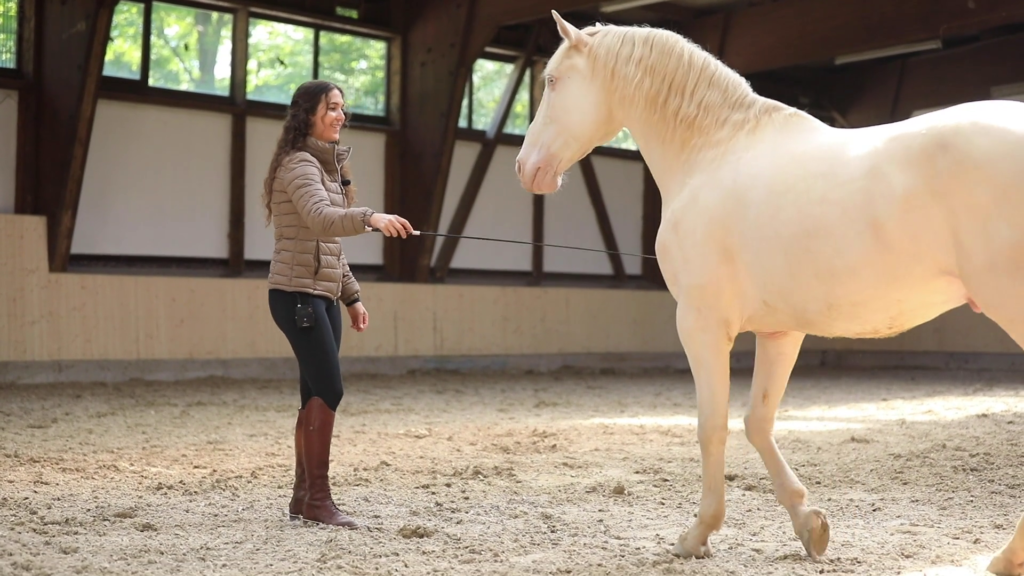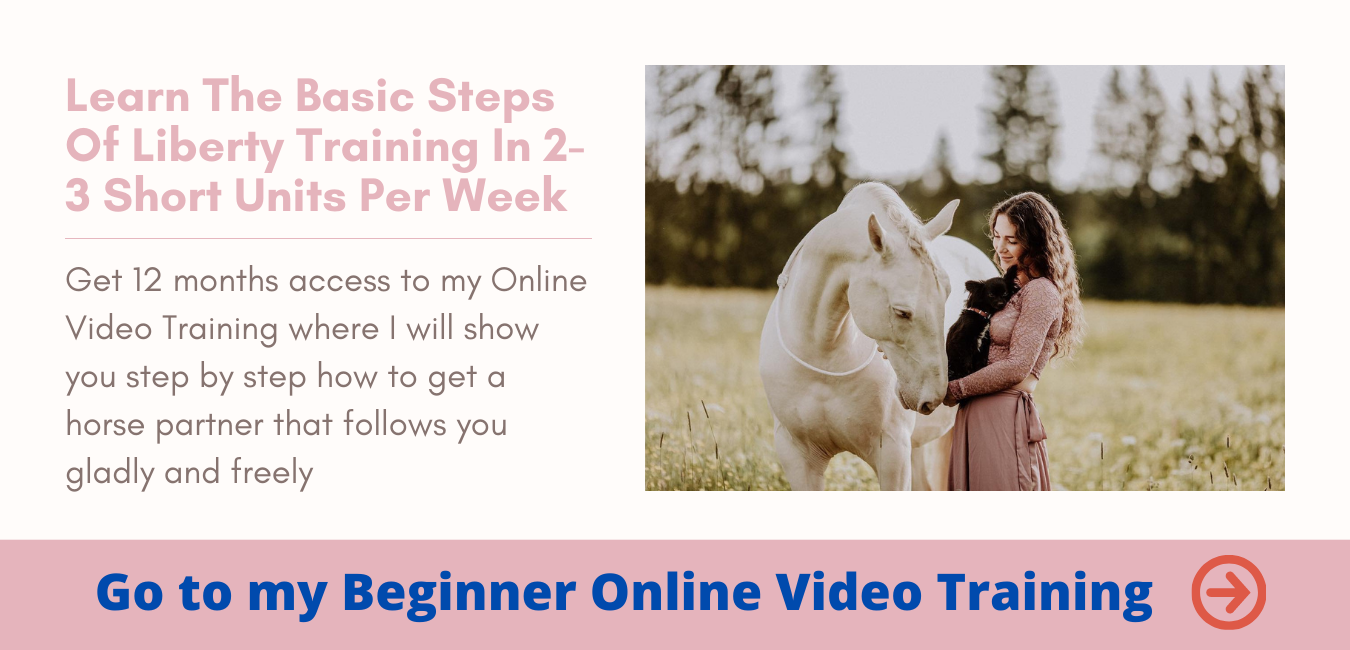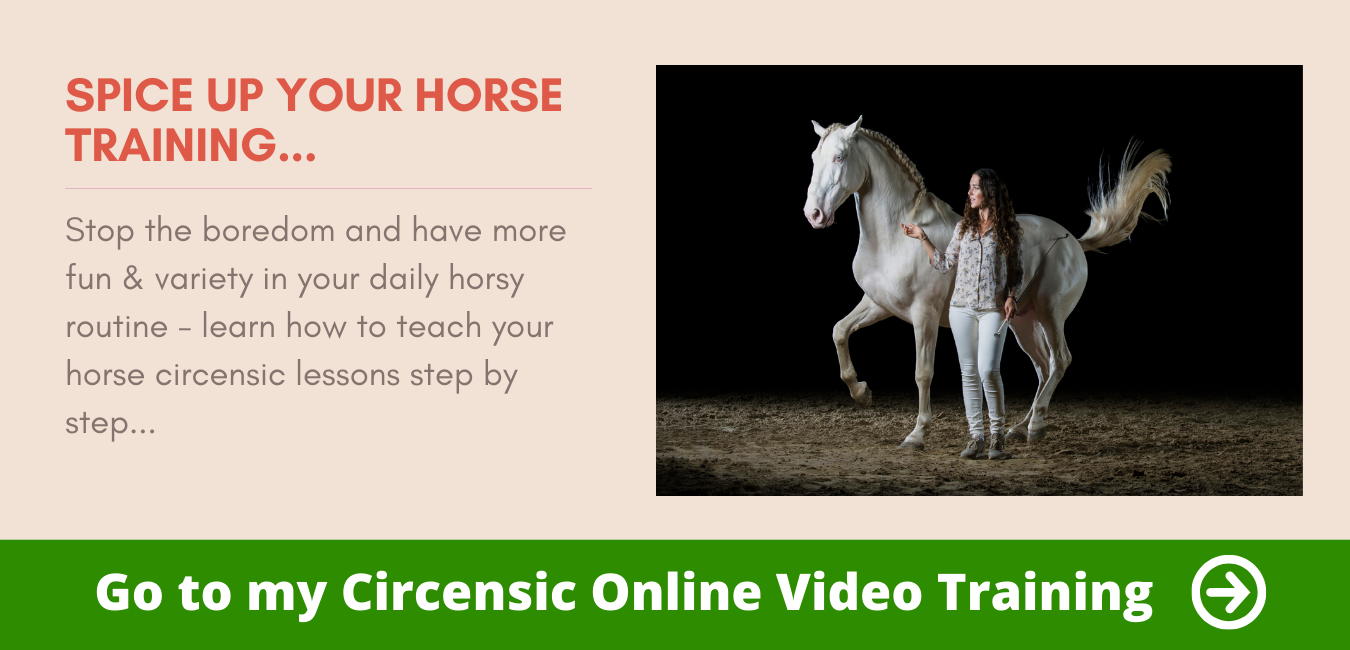Maybe you also read discussions again and again when it comes to equipment on the horse – no matter if it is about crops, spurs, sprouts, binders, etc.
And what makes sense and what does not?
Is liberty dressage even free?
Especially in liberty dressage, any kind of equipment on the horse is heavily discussed.
Because “free” in liberty dressage also means freedom, doesn’t it? The freedom to walk, the freedom to say “no” – and that needs accordingly more confidence, doesn’t it? And neither a knot halter nor a rope, right?
At this point of the discussion, I think there is a very fundamental decision that everyone should make for themselves.
Because yes, liberty dressage is “free” and yet our training is based on making our horse very comfortable to be close to us – and running away is rather exhausting.
Since we actually always work in a fenced area, our horse is never “really free”. And for safety reasons, it should never be!
But what I would like to say with this:
Every kind of horse training influences the “freedom” of the horse.
Even the type of keeping makes our horse more or less “unfree” – because at the end of the widest meadow there is a fence waiting again. But that does not have to be a bad thing per se!
Freddy Knie, the founder of liberty dressage, so to speak, has already said: “The joy of work is the substitute we should give the horse for the lost freedom.
And that’s how I see it too. No matter which aids belong to the horse and which do not.
In the center of attention we should do everything we do first of all FOR our horses. And only much later for us and the progress in our training.
So the first question we should ask ourselves with every piece of equipment and every accessory is
Does this item help me or my horse?
And if you cannot answer this question clearly with “my horse”, you should question the sense of this item, its use and also your handling of it quite objectively.
But what does this mean for saddle, snaffle, spurs and co.
Let’s simply go through the equipment that we naturally pack on our horse every day with the help of these questions.
For the saddle it is in any case quite easy to answer:
The original idea was to protect the horse’s back – especially during long rides.
It distributes our weight less selectively, keeps the spine free and is (hopefully!) comfortable for our horse because it has been fitted exactly to his back.
Of course, the odd break or two will also help us achieve a more secure seat, but the basic idea remains “per horse”.
Of course you can always ride without a saddle and in short sessions it helps your sense of balance and is good for your seat, but I would not recommend long trekking rides without a saddle ?
When it comes to the snaffle, things look a bit different.
It serves us as riders by helping us to give the horse clear instructions for “right”, “left” and “stand” in case of doubt – especially when our weight and body aids fail.
So does it benefit us or the horse? Regardless of whether we use a bit or not? The answer is quite clear: Especially us.
However, this does not mean that you should ride with a neck ring only in the future.
Because safety always comes first! But do you understand what I am getting at?
Actually it should be our goal that almost every object on the horse becomes “superfluous” – but in reality it makes sense to make a conscious decision for or against a certain piece of equipment or aid.
It’s not for nothing that when it comes to the snaffle, people say how important it is to have an independent seat for the reins – and how important it is to ride with the body and its weight.
One of the accessories that I have nevertheless quite consciously chosen is the whip, for example.
It’s hard to imagine my training without it – on the one hand, because with the whip as an extended arm I can reach certain areas of my horse better and more safely, e.g. by tapping the hind legs to bring them forward for the mountain goat.
This “arm extension” means that the clearly defined points on which I point or tap to support my horse also have less influence on my other body language – otherwise I would have to bend down to touch the hind legs.
In addition, it is also safer again, because with the whip I can, for example, keep a dominant horse at a distance – before it has approached me up to an arm’s length, in order to give it a tactile stimulus with its hand, which sends it out of my dancing area.
So one is, so to speak, prophylactic work before the horse violates boundaries, the other is “cleaning up after the storm” – because by then the horse has already violated these boundaries.
For me, the positive aspects such as safety and a clearer and more comprehensible communication for the horse clearly outweigh the negative ones.
And as long as I have the whip in my hand, I decide how it is used.
The only factor that has an influence on whether the whip is used for inappropriate punishment, beatings or the like is therefore also ME.
And since violence in training is an absolute NoGo for me, I can use the whip – just like the spurs – for myself with a clear conscience.
[su_youtube url=”https://youtu.be/ymn8-P1P8SA”]
Is good good enough?
In summary: If you consciously decide to use an accessory, that’s fine – provided you always decide for your horse.
For example, just because it takes longer to explain to your horse on the cavesson how he can walk in circles in a balanced and physiologically correct way when lunging, is no argument for me.
However, the fact that I lead my horse in normal everyday life with halter and rope to protect myself, my horse and others from uncontrolled frightening of my horse or the like is a very good argument for “more control” – even if this sounds like a contradiction to liberty dressage at first.
As with many issues, the decisions here are a fine line between your values and principles and the general safety you can and must always make for yourself.
And that is a good thing! Because every horse-human team goes its own way.
To realize that we should make as many decisions for our horses as possible every day, again and again, is definitely a big step in the right direction!
Because it helps to question whether what “has always been done this way” is really good or whether it is time for something new: And only that makes us reflected and good horse people, doesn’t it?
In this sense I wish you today some conscious answers in the everyday “higher, faster, further” madness ?
All the best,
Your Kenzie




